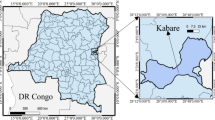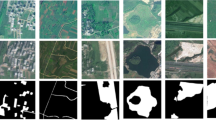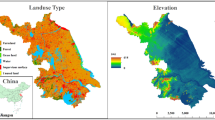Abstract
Damages to crops happen due to natural calamities, irregular fertilization, improper treatment, etc. Estimation of this damage is important in order to plan and execute corrective action strategies. To perform this estimation with high accuracy, both satellite and near-field images are needed. Satellite images assists in evaluation of damages due to natural calamities, while near-field images assist in evaluation of damage due to plant diseases. Separate models are designed for processing these images, which limits their correlative analysis; and thereby reduces overall accuracy of damage detection. To remove this drawback, this text proposes a deep convolutional network (DCN) design that integrates both near-field and far-field images in order to perform effective correlation. Moreover, design of an integrated model would assist researchers to identify and resolve dataset-specific performance gaps. The proposed model analyses different datasets, and estimates performance of context-sensitive classification methods. These are integrated to improve efficiency for multimodal augmented image classification deployments via correlative analysis. This analysis allows the system to predict crop-damages with higher efficiency than individual models. The model is trained for detection of areas which are infected by natural calamities, thereby assisting farm experts to undertake corrective measures based on specific area. Results of proposed model are compared with some of the recently developed state-of-the-art methods, and it is observed that the former model achieves 10% better accuracy, 8% better precision and 5% better recall performance. This evaluation is done on a large number of datasets, thereby assisting in model validation and estimating its usage for multiple type of crops. This text also recommends future research directions that can be undertaken for performance improvement of the underlying model.






Similar content being viewed by others
Explore related subjects
Discover the latest articles, news and stories from top researchers in related subjects.References
Annabel LSP, Annapoorani T, Deepalakshmi P (2018) Machine learning for plant leaf disease detection and classification—a review. Int Conf Commun Signal Process (ICCSP). https://doi.org/10.1109/ICCSP.2019.8698004
Bebber DP, Field E, Gui H, Mortimer P, Holmes T, Gurr SJ (2019) Many unreported crop pests and pathogens are probably already present. Glob Change Biol 25(8):2703–2713. https://doi.org/10.1111/gcb.14698
Cappa F, Bani L, Meriggi A (2021) Factors affecting the crop damage by wild boar (Sus scrofa) and effects of population control in the Ticino and Lake Maggiore Park (North-western Italy). Mamm Biol 101(4):451–463. https://doi.org/10.1007/s42991-021-00125-2
Ceballos F, Kramer B, Robles M (2019) The feasibility of picture-based insurance (PBI): smartphone pictures for affordable crop insurance. Dev Eng. https://doi.org/10.1016/j.deveng.2019.100042
Champ J, Mora-Fallas A, Goëau H, Mata-Montero E, Bonnet P, Joly A (2020) Instance segmentation for the fine detection of crop and weed plants by precision agricultural robots. Appl Plant Sci. https://doi.org/10.1002/aps3.11373
Cuaran J, Leon J (2021) Crop monitoring using unmanned aerial vehicles: a review. Agric Rev. https://doi.org/10.18805/ag.R-180
Dai Q, Cheng X, Qiao Y, Zhang Y (2020) Crop leaf disease image super-resolution and identification with dual attention and topology fusion generative adversarial network. IEEE Access 8:55724–55735. https://doi.org/10.1109/ACCESS.2020.2982055
Dong Y, Xu F, Liu L, Du X, Ye H, Huang W, Zhu Y (2019) Monitoring and forecasting for disease and pest in crop based on WebGIS system. In: G. M. U. Center for Spatial Information Science and Systems (Ed.), 8th International Conference on Agro-Geoinformatics (Agro-Geoinformatics) (pp. 1–5). IEEE. https://doi.org/10.1109/Agro-Geoinformatics.2019.8820620.
Egerer M, Liere H, Lucatero A, Philpott SM (2020) Plant damage in urban agroecosystems varies with local and landscape factors. Ecosphere. https://doi.org/10.1002/ecs2.3074
Hari SR, Veeraraghavan AK, Sivaraman UK, Ramachandran (2018) Application of uav for pest, weedsand disease detection using open computer vision. In: Vedhapriyavadhana R (ed) International Conference on Smart Systems and Inventive Technology (ICSSIT 2018) (pp. 287–292). IEEE
Honda T (2021) Geographical personality gradient in herbivorous animals: Implications for selective culling to reduce crop damage. Ecol Res 36(1):145–151. https://doi.org/10.1111/1440-1703.12186
Jadhav SB, Udupi VR, Patil SB (2021) Identification of plant diseases using convolutional neural networks. Int J Inform Technol (Singapore) 13(6):2461–2470. https://doi.org/10.1007/s41870-020-00437-5
Kamesaka R, Hoshino Y (2018) Development of a prevention system for beast damage of agricultural products using deep learning. In: Proceedings—2018 Joint 10th International Conference on Soft Computing and Intelligent Systems and 19th International Symposium on Advanced Intelligent Systems, SCIS-ISIS 2018, 747–752. https://doi.org/10.1109/SCIS-ISIS.2018.00124
Kasinathan T, Singaraju D, Uyyala SR (2021) Insect classification and detection in field crops using modern machine learning techniques. Inform Process Agric 8(3):446–457. https://doi.org/10.1016/j.inpa.2020.09.006
Kulkarni O (2018) Crop disease detection using deep learning. Fourth Int Conf Comput Commun Control Autom (ICCUBEA). https://doi.org/10.1109/ICCUBEA.2018.8697390
Lakmal D, Kugathasan K, Nanayakkara V, Jayasena S, Perera AS, Fernando L (2019) Brown planthopper damage detection using remote sensing and machine learning. In: Proceedings—18th IEEE International Conference on Machine Learning and Applications, ICMLA 2019, 97–104. https://doi.org/10.1109/ICMLA.2019.00024
Larijani MR, Asli-Ardeh EA, Kozegar E, Loni R (2019) Evaluation of image processing technique in identifying rice blast disease in field conditions based on KNN algorithm improvement by K-means. Food Sci Nutr 7(12):3922–3930. https://doi.org/10.1002/fsn3.1251
Lee SH, Lin SR, Chen SF (2020) Identification of tea foliar diseases and pest damage under practical field conditions using a convolutional neural network. Plant Pathol 69(9):1731–1739. https://doi.org/10.1111/ppa.13251
Li W, Chen P, Wang B, Xie C (2019) Automatic localization and count of agricultural crop pests based on an improved deep learning pipeline. Sci Rep. https://doi.org/10.1038/s41598-019-43171-0
Mardanisamani S, Maleki F, Kassani SH, Rajapaksa S, Duddu H, Wang M, Shirtliffe S, Ryu S, Josuttes A, Zhang T, Vail S, Pozniak C, Parkin I, Stavness I, Eramian M (2019) Crop lodging prediction from UAV-acquired images of wheat and canola using a DCNN augmented with handcrafted texture features. IEEE/CVF Conf Comput Vis Pattern Recogn Worksh (CVPRW). https://doi.org/10.1109/CVPRW.2019.00322
Mohammadi M, Darabi H, Mirchooli F, Bakhshaee A, Torabi Haghighi A (2021) Flood risk mapping and crop-water loss modeling using water footprint analysis in agricultural watershed, northern Iran. Nat Hazards 105(2):2007–2025. https://doi.org/10.1007/s11069-020-04387-w
Montràs-Janer T, Knape J, Nilsson L, Tombre I, Pärt T, Månsson J (2019) Relating national levels of crop damage to the abundance of large grazing birds: implications for management. J Appl Ecol 56(10):2286–2297. https://doi.org/10.1111/1365-2664.13457
Nuttall JG, Perry EM, Delahunty AJ, O’Leary GJ, Barlow KM, Wallace AJ (2019) Frost response in wheat and early detection using proximal sensors. J Agro Crop Sci 205(2):220–234. https://doi.org/10.1111/jac.12319
Patel D, Bhatt N (2021) Improved accuracy of pest detection using augmentation approach with Faster R-CNN. IOP Conf Ser Mater Sci Eng 1042(1):012020. https://doi.org/10.1088/1757-899x/1042/1/012020
Rahman MS, Di L, Yu E, Lin L, Yu Z (2021) Remote sensing based rapid assessment of flood crop damage using novel disaster vegetation damage index (DVDI). Int J Disaster Risk Sci 12(1):90–110. https://doi.org/10.1007/s13753-020-00305-7
Rustia DJA, Chao JJ, Chiu LY, Wu YF, Chung JY, Hsu JC, te Lin T (2021) Automatic greenhouse insect pest detection and recognition based on a cascaded deep learning classification method. J Appl Entomol 145(3):206–222. https://doi.org/10.1111/jen.12834
Schlötelburg A, Plekat A, Bellingrath-Kimura S, Jacob J (2020) Self-service traps inspected by avian and terrestrial predators as a management option for rodents. Pest Manag Sci 76(1):103–110. https://doi.org/10.1002/ps.5550
Selvaraj MG, Vergara A, Ruiz H, Safari N, Elayabalan S, Ocimati W, Blomme G (2019) AI-powered banana diseases and pest detection. Plant Methods. https://doi.org/10.1186/s13007-019-0475-z
Shang Y, Kamrul Hasan M, Ahammed GJ, Li M, Yin H, Zhou J (2019) Applications of nanotechnology in plant growth and crop protection: a review. In: Molecules (Vol. 24, Issue 14, pp. 1–23). MDPI AG. https://doi.org/10.3390/molecules24142558
Sharma P, Berwal YPS, Ghai W (2020) Performance analysis of deep learning CNN models for disease detection in plants using image segmentation. Inform Process Agric 7(4):566–574. https://doi.org/10.1016/j.inpa.2019.11.001
Wu H, Wiesner-Hanks T, Stewart EL, DeChant C, Kaczmar N, Gore MA, Nelson RJ, Lipson H (2019) Autonomous detection of plant disease symptoms directly from aerial imagery. Plant Phenome J 2(1):1–9. https://doi.org/10.2135/tppj2019.03.0006
Yang H, Gao L, Tang N, Yang P (2019) Experimental analysis and evaluation of wide residual networks based agricultural disease identification in smart agriculture system. Eurasip J Wirel Commun Netw. https://doi.org/10.1186/s13638-019-1613-z
Author information
Authors and Affiliations
Corresponding author
Additional information
Publisher's Note
Springer Nature remains neutral with regard to jurisdictional claims in published maps and institutional affiliations.
Rights and permissions
Springer Nature or its licensor holds exclusive rights to this article under a publishing agreement with the author(s) or other rightsholder(s); author self-archiving of the accepted manuscript version of this article is solely governed by the terms of such publishing agreement and applicable law.
About this article
Cite this article
Dhande, A., Malik, R. Design of a highly efficient crop damage detection ensemble learning model using deep convolutional networks. J Ambient Intell Human Comput 14, 10811–10821 (2023). https://doi.org/10.1007/s12652-022-04352-4
Received:
Accepted:
Published:
Issue Date:
DOI: https://doi.org/10.1007/s12652-022-04352-4




